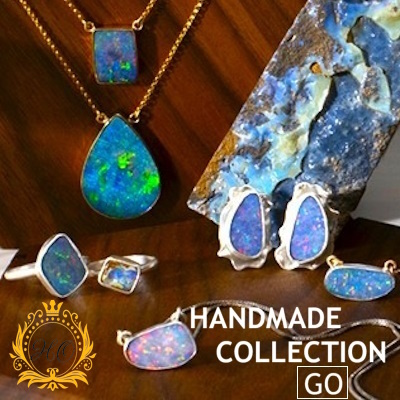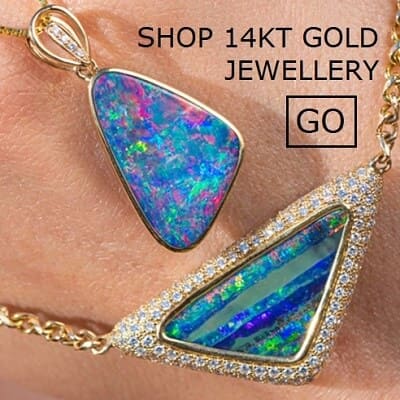What Is White Opal? Complete Guide for Collectors
Posted by AOD on 24th Oct 2025
What Is White Opal? Complete Guide for Collectors

Did you know that white opals make up about 60 percent of all opal mined worldwide? These gems may look unassuming at first glance, but their subtle flashes of color have fascinated both collectors and jewelers for generations. With origins rooted in the famed fields of South Australia, white opals offer a gentle yet captivating beauty. Explore how their unique patterns, mineral makeup, and mining regions set them apart, revealing details that inspire both new and experienced enthusiasts.
Table of Contents
- Defining White Opal And Core Characteristics
- Major Types Of White Opal In Australia
- Distinct Visual Features And Patterns
- Origins: Key Australian White Opal Regions
- Evaluating Value And Authenticity Factors
- Comparing White Opal To Other Varieties
Key Takeaways
| Point | Details |
|---|---|
| Prevalence of White Opal | White opals make up approximately 60% of all opals mined globally, primarily sourced from South Australia. |
| Varieties by Region | Notable types include Coober Pedy, Andamooka, and Mintabie, each with distinct visual attributes and geological characteristics. |
| Value Determinants | Key value factors include color spectrum, pattern complexity, body tone, and geological integrity, vital for collectors to consider. |
| Comparison with Other Opals | White opals offer a lighter body tone and affordability compared to black and fire opals, appealing to both novice and seasoned collectors. |
Defining White Opal and Core Characteristics
White opal represents the most abundant type of opal worldwide, sourced predominantly from the legendary gemstone regions of South Australia. White opals are distinguished by their light body tone, typically ranging from milky white to soft grey, which provides a subtle canvas for displaying vibrant color play. According to research from Opal Quest, these opals are primarily discovered in mining areas like Coober Pedy, Andamooka, and Mintabie.
The core characteristics of white opals make them unique among gemstones. These gems are characterized by:
- Light body tone (generally N8 to N9 on the geological scale)
- Potential to display multiple spectral colors
- Predominantly milky-opaque appearance
- Softer visual presentation compared to black or boulder opals
Geologically, white opals contain magnesium oxide, which contributes to their distinctive pale base. As noted by the Australian Opal Organization, white opals represent approximately 60% of all opals mined globally, making them significantly more common than their more exotic counterparts. Their prevalence does not diminish their beauty - each white opal offers a unique interplay of subtle colors that can captivate collectors and jewelry enthusiasts alike.
White opals offer an accessible entry point for those new to collecting precious stones. Their softer color palette and reasonable availability make them an excellent choice for both novice collectors and seasoned gemstone aficionados seeking elegant, understated pieces with mesmerizing light interactions.

Major Types of White Opal in Australia
Australia boasts several distinct varieties of white opal, primarily sourced from three legendary mining regions in South Australia. Coober Pedy white opals, the most renowned type, feature a characteristic milky white to light grey body tone and are famous for their subtle yet captivating color play. Types of Opal in Australia reveal that these opals represent the quintessential white opal experience.
The major white opal types found in Australian mines include:
Here’s a comparison of major Australian white opal types by mining region:
| Opal Type | Mining Region | Visual Characteristics | Notable Features |
|---|---|---|---|
| Coober Pedy White Opal | Coober Pedy | Milky white to soft grey body Subtle color play |
Most abundant Classic white opal |
| Andamooka White Opal | Andamooka | Slightly more translucent Gentle color spectrum |
Distinct mineral content |
| Mintabie White Opal | Mintabie | Unique mineral composition Pale base tone |
Rarer, regional distinctions |
- Coober Pedy White Opal: Predominantly light-toned with soft color spectrum
- Andamooka White Opal: Known for slightly more translucent appearance
- Mintabie White Opal: Characterized by its unique mineral composition
According to research from the Australian Opal Organization, these white opals share common geological characteristics. They typically contain magnesium oxide, which contributes to their distinctive pale base. Each region produces white opals with subtle variations in tone, transparency, and color potential, making them fascinating for collectors who appreciate nuanced gemstone differences.
While these white opals might appear similar to the untrained eye, experienced collectors recognize the unique signature of each mining region.
Distinct Visual Features and Patterns
White opals are renowned for their mesmerizing visual complexity, displaying a remarkable array of unique patterns that captivate collectors and gemstone enthusiasts. According to Opal Quest, these gems can range from milky-opaque to subtly translucent, creating a canvas for extraordinary light interactions and color displays.
The most intriguing aspect of white opals is their diverse pattern repertoire:
- Harlequin Pattern: The rarest and most valuable, featuring geometric shapes
- Broadflash Pattern: Large, sweeping color movements across the stone
- Chaff Pattern: Resembling scattered light fragments
- Chinese Writing Pattern: Intricate, linear design reminiscent of script
- Mackerel Pattern: Reflecting fish-scale-like iridescence
Research from All Gem indicates that these patterns are not just visual curiosities but critical determinants of an opal’s value. The harlequin pattern, with its precise geometric arrangement, represents the pinnacle of white opal collectibility, commanding premium prices among serious gemstone collectors.
Understanding these visual features requires an appreciation of the subtle interplay between light, mineral composition, and geological formation. Each pattern tells a unique story of the opal’s origin, making white opals not just gemstones, but miniature geological narratives waiting to be deciphered by those with a discerning eye.
Origins: Key Australian White Opal Regions
The story of white opal begins in the rugged, sun-scorched landscapes of South Australia, where three legendary mining regions have earned global recognition for producing exceptional gemstones. Where is white opal from reveals the fascinating geological narrative of these remarkable deposits, with each location contributing its unique geological signature to the white opal market.
The primary white opal regions in Australia include:
- Coober Pedy: The undisputed ‘Opal Capital of the World’
- Andamooka: Known for distinctive mineral compositions
- Mintabie: A region with unique geological formations
According to the Australian Opal Organization, Coober Pedy stands out as the most significant source, representing approximately 60% of all white opal mined globally. Discovered in 1915, this isolated region has transformed from a remote mining outpost to a world-renowned geological treasure trove. Research from Opal Quest highlights that each of these regions contributes unique characteristics to white opals, making them more than just gemstones - they are geological time capsules capturing millions of years of Earth’s intricate processes.
Evaluating Value and Authenticity Factors
Authentic white opals represent a complex interplay of geological characteristics and visual phenomena that determine their true value. According to Opal Quest, collectors and gemstone enthusiasts must consider multiple sophisticated factors when assessing these remarkable stones.
Key value determinants for white opals include:
- Color Spectrum: Number and vibrancy of displayed colors
- Pattern Complexity: Rarity of geometric arrangements
- Body Tone: Clarity and translucency of base tone
- Color Contrast: Dramatic shifts between color ranges
- Geological Integrity: Absence of significant inclusions or marks
All Gem research indicates that the most valuable white opals demonstrate exceptional color transitions, particularly dramatic shifts like red to green. While white opals are generally less valuable than their black opal counterparts, specimens with crystal-like properties that enhance color clarity can command premium prices.
Authenticity requires more than visual assessment. Experienced collectors understand that each white opal tells a geological story, with its value rooted in the nuanced interplay of mineral composition, light refraction, and the unique environmental conditions of its Australian origin. The true worth of a white opal lies not just in its immediate aesthetic appeal, but in its ability to capture millions of years of Earth’s intricate crystallization processes.
Comparing White Opal to Other Varieties
The world of opals is rich with diversity, and white opals occupy a unique position within this spectacular gemstone family. What Are the Different Types of Opal reveals the nuanced distinctions that set white opals apart from their more dramatic counterparts.
Key comparative characteristics include:
- White Opal: Lighter body tone, more abundant, more affordable
- Black Opal: Dark body tone, rarest, most valuable
- Boulder Opal: Naturally attached to ironstone matrix
- Crystal Opal: Transparent with vibrant color play
- Fire Opal: Predominantly orange to red coloration
According to the Australian Opal Organization, white opals represent approximately 60% of all opals mined, making them significantly more accessible than black opals, which are primarily found in Lightning Ridge, New South Wales. Research from All Gem highlights that while white opals typically exhibit less vibrant colors due to their pale body tone, they offer collectors an elegant, understated alternative to more dramatic opal varieties.
The beauty of white opals lies in their subtlety. Where black opals demand attention with intense color play, white opals whisper their geological stories through delicate, nuanced color transitions. This makes them not just gemstones, but miniature landscapes capturing millions of years of Earth’s intricate crystallization processes.
Discover the True Beauty of White Opal with Australian Opal Direct
Navigating the rich world of white opals can be challenging for collectors who seek authenticity and meaningful value. This guide reveals key insights into white opal’s body tone, distinctive patterns like the harlequin, and regional origins that deeply influence each stone’s character. If you want to find a genuine white opal that carries the unique story of Australian geology while showcasing mesmerizing color play, trust in a source that connects you directly to the mines where these treasures are born.

Explore our carefully curated collection at Australian Opal Direct, where every white opal ring, pendant, or custom-designed piece is ethically sourced from iconic regions like Coober Pedy. Gain confidence with our heritage narratives, free shipping, and 90-day warranties. Start your journey now to own a premium white opal that embodies millions of years of Earth’s story and enjoys unmatched craftsmanship. Visit our site and see for yourself why collectors rely on us for authentic Australian opals.
Frequently Asked Questions
What are the core characteristics of white opal?
White opals are characterized by a light body tone, typically milky white to soft grey, and display a vibrant color play. They often have a milky-opaque appearance, which is softer compared to black or boulder opals, and contain magnesium oxide contributing to their distinctive pale base.
How does white opal compare to other types of opal?
White opal has a lighter body tone and is more abundant and affordable compared to black opal, which is darker and rarer. Other opal varieties, like boulder opals and crystal opals, exhibit different visual characteristics, such as being attached to an ironstone matrix or being transparent with vibrant colors, respectively.
What visual features and patterns can be found in white opal?
White opals can display a variety of patterns, including Harlequin, Broadflash, Chaff, Chinese Writing, and Mackerel patterns. These patterns significantly influence the opal’s value, with the Harlequin pattern being the rarest and most desirable among collectors.
What factors influence the value of white opal?
The value of white opal is determined by several factors, including the vibrancy of its color spectrum, the complexity of its patterns, the clarity of its body tone, the contrast of colors displayed, and the geological integrity of the stone, which includes the absence of inclusions or significant marks.




